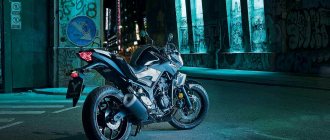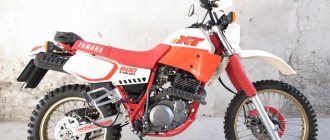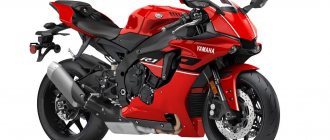| Yamaha WR250F (2001-2002) | Yamaha WR250F (2003-2004) | Yamaha WR250F (2005-2006) | Yamaha WR250F (2007-2010) |
| Yamaha WR250F (2011-2014) | Yamaha WR250F (2015-2017) | Yamaha WR250F (2018-2021) | Yamaha WR250F (2022+) |
| Yamaha WR250R (2007-2009) | Yamaha WR250R (2010-2020) | Yamaha WR250X (2007-2017) |
Yamaha WR 250 off-road motorcycle series
appeared on the market in 2001 with the
Yamaha WR250F
. The motorcycle was built on the basis of the motocross version of the Yamaha YZ250F, differing from it in the presence of headlights, suspension settings, engine and gearbox, exhaust, and larger radiators.
In 2007, the Yamaha WR250F model received an aluminum frame, and the WR250 series itself was replenished with two more models - the Yamaha WR250R
(soft enduro) and
Yamaha WR250X
(motard). The new versions are built on the basis of the WR250F, but differ in the settings of the suspension, engine (deformed, has 4 valves), the presence of an injection power system, 6-speed gearbox, etc. The motard version of the WR250X differs from the soft enduro WR250R in having 17′ road wheels, larger the diameter of the front brake disc (298 mm versus 250 mm), suspension settings (slightly reduced travel, increased rigidity) and chassis geometry.
By 2015, the hard enduro modification of the Yamaha WR250F receives serious updates - a new 4-valve engine with a higher compression ratio (13.5 versus 12.5:1), an injection power system, a new TCI transistor ignition, a 6-speed gearbox.
2017 marked the final year of production for the Yamaha WR250X version, while enduro variants are still being produced and sold in the European and North American markets.
At the end of 2022, Yamaha introduced the new generation Yamaha WR250F
. The model received a new frame, a new engine (the compression ratio was increased, the shape of the camshafts was changed, the cylinder head intake ports were modified, the gearbox settings were changed), a new brake system (the front disc diameter increased to 270 mm) and a new display.
Main competitors of Yamaha WR250 motorcycles:
- Honda CRF250X
- Honda CRF250L (250M)
- Kawasaki KLX250 / Kawasaki D-Tracker 250 / KX250X
001_MOTO_0310_032
Yamaha WR250R, enduro, 2009, 249 cm3, 30.7 hp, 134 kg, RUB 339,700.
Yamaha WR250R, enduro, 2009, 249 cm3, 30.7 hp, 134 kg, RUB 339,700.
NOT ACCORDING TO PLAN. If you want to make God laugh, tell him about your plans, says a famous proverb. We planned the Yamaha WR250R test for the beginning of December, remembering that in recent years snow has not fallen in the middle zone any earlier. In addition, I wanted not only to ride, but also to take part in the annual “Connecting Bear” rally, held by the Yaroslavl MS “Black Bears” (“Moto”, No. 2–2010). “There will definitely be a lot of snow in Yarik, but it’s still noticeably north of the capital,” I thought, taking out my winter gear from the mezzanine. Nature turned out to be much more inventive in terms of jokes on me, naive. Just before the start of the test, snow began to fall in Moscow and the surrounding area, and even the shooting turned out to be quite wintery. As for the test itself near Yaroslavl, the height of the snow cover mockingly melted in proportion to the approach to the starting point. Well, quite seasonal “minus eight” with an invigorating breeze, firmly frozen ground, ice in puddles and an almost complete absence of snow. You can’t imagine anything worse - the dirt is already frozen and is as hard as asphalt, slippery, like on a skating rink, and there is no soft snow in which you could “land” softly and pleasantly. But you will have to hit it. The Michelin Cross Competition S12 cross-country tires, although toothy, are not at all designed for driving on ice: the already hard tire, having become quite hard in the cold, behaved like slicks, so by the end of the route I could be diagnosed with “a bruise of the whole grandma” " But we’re not testing me, but a motorcycle, so we’ll turn to that.
Brief history of the model
- 2001 - start of production and sales of Yamaha WR250F.
Model
: Yamaha WR250F (Europe, North America, Oceania, etc.).
Factory designation
: 5PH1, 5PH2, 5PH1, WR250FN (USA).
- 2002 - no significant changes.
Model
: Yamaha WR250F (Europe, North America, Oceania, etc.).
Factory designation
: 5PH5, 5PH6, 5PH8, WR250FP (USA).
- 2003 - no significant changes.
Model
: Yamaha WR250F (Europe, North America, Oceania, etc.).
Factory designation
: 5UM1, 5UM2, 5UM4, WR250FR (USA).
- 2004 - no significant changes.
Model
: Yamaha WR250F (Europe, North America, Oceania, etc.).
Factory designation
: 5UM5, 5UM6, 5UM7, WR250FS (USA).
- 2005 - the diameter of the front fork increases to 48 mm.
Model
: Yamaha WR250F (Europe, North America, Oceania, etc.).
Factory designation
: 5UM8, 5UM9, 5UMA, WR250FT (USA).
- 2006 - The WR250F gains a digital instrument cluster.
Model
: Yamaha WR250F (Europe, North America, Oceania, etc.).
Factory designation
: 5UMB, 5UMC, 5UMD, WR250FV (USA).
- 2007 - The WR250F gains an aluminum frame. The appearance of modifications WR250R and WR250X.
Model
: Yamaha WR250F;
Yamaha WR250R; Yamaha WR250X (all markets). Factory designation
: 5UME, 5UMF, 5UMG, WR250FW (USA); 3D71 (Japan); 3D72 (Japan).
- 2008 - no significant changes.
Model
: Yamaha WR250F;
Yamaha WR250R; Yamaha WR250X (all markets). Factory designation
: 5UML (Europe), WR250FX (USA); WR25RXCL (USA), 32D1, 32D3, 32C5; WR25XXCL (USA), 32D4 (Australia), 32D2 (Europe).
- 2009 - no significant changes.
Model
: Yamaha WR250F;
Yamaha WR250R; Yamaha WR250X (all markets). Factory designation
: 5UMP, 5UMR, 5UMS, WR250FY (USA); WR25RYL (USA), 3D73, 32CB, 32D5; WR25XYB (USA), 3D74 (Japan), 32D6 (Europe).
- 2010 - Yamaha WR250R and Yamaha WR250X models receive new suspensions - KYB inverted forks and Soqi adjustable monoshock.
Model
: Yamaha WR250F;
Yamaha WR250R; Yamaha WR250X (all markets). Factory designation
: 5UMU, 5UMV; WR25RZL (USA), 3D75, 32DB, 32CH; 32DC, 32CJ, 3D76.
- 2011 - no significant changes.
Model
: Yamaha WR250F;
Yamaha WR250R; Yamaha WR250X (Europe, North America, Japan). Factory designation
: WR250FA (USA), 1HC2, 1HC3; WR25RAL (USA), 32DF, 32CP, 3D77; WR25XAW (USA), 32CR, 3D78.
- 2012 - no significant changes.
Model
: Yamaha WR250F;
Yamaha WR250R; Yamaha WR250X (Europe, North America, Japan). Factory designation
: WR250FB (USA), 1HC6, 1HC7; WR25RBL (USA), 3D79, 32DH, 32CW; 32DJ, 3D7A.
- 2013 - no significant changes.
Model
: Yamaha WR250F;
Yamaha WR250R (Europe, North America, Japan). Factory designation
: WR250FD (USA), 1HCA, 1HCB; WR25RD (USA), 3D7B, 32DN, 2CF3.
- 2014 - no significant changes.
Model
: Yamaha WR250F;
Yamaha WR250R; Yamaha WR250X (Europe, North America, Japan). Factory designation
: 1HCD; WR25RE (USA), 3D7C, 32DT, 2CF6; 3D7D, 32DP.
- 2015 - Yamaha WR250F model receives a new 4-valve (instead of 5-valve) engine with an increased compression ratio (from 12.5 to 13.5), electronic fuel injection, transistor ignition system, new adjustable KYB suspension and 6-speed Checkpoint.
Model
: Yamaha WR250F;
Yamaha WR250R (Europe, North America, Japan). Factory designation
: WR250FF, 2GB2, 2GB3; WR25RF (USA), 3D7E, 32DW, 2CF9.
- 2016 - no significant changes.
Model
: Yamaha WR250F;
Yamaha WR250R; Yamaha WR250X (Europe, North America, Japan). Factory designation
: WR250FG, 2GB6, 2GB7, 2GB8; WR25RG (USA), 3D7G, BN32, 2CFC; 3D7F.
- 2017 is the final year of production for the Yamaha WR250X.
Model
: Yamaha WR250F;
Yamaha WR250R; Yamaha WR250X (Europe, North America, Japan). Factory designation
: WR250FH, 2GBC, 2GBD; WR25RH (USA), 3D7H, 2CFF; 3D7J.
- 2018 - no significant changes.
Model
: Yamaha WR250F;
Yamaha WR250R (Europe, North America). Factory designation
: WR250FJ, 2GBG, 2GBH; WR250RJ.
- 2019 - no significant changes.
Model
: Yamaha WR250F;
Yamaha WR250R (Europe, North America). Factory designation
: WR250FK; WR250RK.
- 2020 - no significant changes.
Model
: Yamaha WR250F; Yamaha WR250R (Europe, North America, Australia).
- 2021 - no significant changes.
Model
: Yamaha WR250F (Europe, North America, Australia).
- 2022 - Yamaha WR250F restyling.
Model
: Yamaha WR250F (Europe, North America, Australia).
002_MOTO_0310_033
MAKE THE WAY TO THE YOUNG. At first glance, the WR is not much different from the now classic Iksers, Tters and other Deers, except that the design of the plastic is more modern. In reality, this “check” is much more serious. And, as usual, the main thing is not visible from the outside. Firstly, a diagonal aluminum alloy frame has finally arrived in the 250 class. Having already become familiar on cross-country equipment, it is in no hurry to retire the steel duplexes of dual-purpose motorcycles. (Like, who cares about a button accordion? There is an opinion that “for rides around the dacha” a super-stiff and light frame is useless. And iron is cheaper.) So WR is the exception rather than the rule, but, looking ahead, I will say that The exception is very pleasant and useful.
Probably the only full-fledged competitor to the WR250R is the KTM 250 EXC-F, and even then, once you look under the plastic, the “Austrian” disappears into the shadow of its Japanese counterpart: the most important difference between the WR and all its peers is the fuel injection system. Perhaps for the first time in the world, Yamaha approached the design of a 250 cc “endurance” not as a “budget moped for beginners”, but as a serious device. In addition to a frame made using cross-country technology (the design is borrowed from the YZ series) and a fuel injection system, the motorcycle is equipped with a catalytic converter, a full set of lighting equipment, a dashboard with a large LCD monitor and even passenger footpegs. All this makes it not only the most advanced in its class, but also suitable for driving on public roads (by the way, it is the only one in the line of Yamaha SUVs officially supplied to Russia). At the same time, the equipped device does not weigh that much - 134 kg. Of course, a purely sporty WR450 will be lighter, but in comparison with its classmates - take the same "Baja" - the difference of 10 kilos is not so great. Moreover, if the goal is to lighten the device, even a simple replacement of the “can”, in which, in addition to the muffler, a neutralizer is also installed, with a tuning one will almost immediately eliminate this difference. The only thing that upset me was the lack of a kickstarter. A device that claims to be a serious conqueror of the “pampas” is without it. It seems clear that an injection engine cannot be started with a “dead” battery, but there are batteryless injection systems in motocross, right? If they made the device “with all the money”, why did they save? Unclear.
The classic type of motorcyclist is internally relaxed, he himself determines the boundaries of what is permitted, the law for him is only a recommendation* In general, one of the myths of the motorcycle world. Such a guy definitely gets a chopper or a cruiser. Why not a supermotard? For example, the new Yamaha WR250X, which is as free-spirited as the ideal biker, and in terms of rules and regulations, this supermoto is conveniently located NEXT TO THE LAW
YAMAHA WR250X, supermotard
...GRAVITY.
Gravity doesn't always affect the WR250X: either the front or rear wheels alternately lift off the asphalt, or even both at once. Don't be surprised - this lightweight supermotard has an excellent chassis: there is an aluminum frame, an adjustable inverted fork, and excellent brakes. The WR seems lighter than it actually is: 128 kg dry weight for a 250 is not the best indicator. For example, the main competitor of the “Ver” – the Kawasaki KLX250D-Tracker supermoto (which is not sold new in Russia) weighs as much as 12 kg lighter, and the Honda XR250 Motard with an “air-blower” motor – 8 kg. But neither in motion nor in static conditions does the Yamaha seem heavier than them.
Handling is its best quality. It makes sharp, fast turns, maneuvering in traffic, and “slalom” between the pits of Russian “autobahns” easily and naturally. But at the beginning of the test, the WR was capricious and rode as it wanted, until I adjusted the suspension “to suit me”: I changed the rebound and compression damping - and the ride of the motorcycle became different.
From the enduro WR250 with the R index, which we have already tested (see “Moto”, No. 8-2008), the X version differs more than it seems at first glance. When developing it, Yamaha were not content with limited tuning: the modification with the X index has a “lightened” driven sprocket by one tooth, the gear ratios in the gearbox have been changed, the fork offset angle has been slightly compressed, the wheelbase has been stretched by 5 mm, other than in R, suspension settings, and a 298mm rather than 250mm front brake disc. The ground clearance and saddle height are 35 mm lower, which I personally, being short, appreciated: I had to climb the enduro 250R like Przewalski’s steppe horse. Otherwise, the motorcycles are the same: narrow saddle, wide handlebars with round mirrors, the same tank, plastic, optics. Well, the same engine.
...TRAFFIC.
During my testing of the WR250X, I violated the traffic rules so many times that I estimate that the amount of hypothetical fines could be close to the cost of the test bike. This is despite the fact that I consider myself a disciplined driver: I try to behave decently both in a car and on a motorcycle. No, of course, I didn’t commit any serious violations - I didn’t drive into the oncoming lane, I didn’t jump through a red traffic light. But I can’t count how many times I drove around the edges of lawns, absolutely “dead” traffic jams, took shortcuts through the alleys of parks and squares (deserted!), exceeded, I confess, the speed limit and violated the traffic lane. I even took a ride through the underground passage once - at night, when there were no people or traffic cops nearby. (The photographer asked me to drive along the overpass above the highway, but I did not succumb to this blatant provocation... Although the temptation was oh so great!) And why?
All motorcycles influence the pilot's driving style to a greater or lesser extent. Agree, traveling at 60 km/h on a sportbike or squeezing maximum speed from a chopper is not normal. But the WR250X doesn’t just influence - it literally suppresses the will of the rider and dictates its own rules that differ from the requirements of the traffic rules. The reason for this is the ease with which the supermoto is controlled, and the 30-horsepower engine, which does not know how to “pull” at the “bottoms”, like, say, the “air blowers” of the Honda XR series.
For the WR250X to be fast, you need to click the gearbox gears at lightning speed and “unscrew” the engine all the way. The effect of engine braking is again convenient to use if the engine is operating at high speeds: when the crankshaft has not yet had time to spin up properly, if you close the gas, the speed will drop so quickly that the engine may stall. This, you understand, is inconvenient: squeezing between rows of cars, out of habit, you slow down the engine. On the WR this number does not work - you have to constantly apply the gas and coast with the clutch depressed.
A special “wow!” about the rear brake. Locking the rear wheel on the WR250X is as much fun as doing a stoppie or wheelie. A light touch on the brake foot - and the “stern” goes into free swimming. Free as much as you allow.
... PSYCHOLOGY.
To an experienced pilot, the WR250X engine will seem sluggish at first - this was the case with me... After two hours of riding, when the motorcycle had already dominated my brain and suppressed my will, the thought dawned: but the engine is not so weak... After another hour I was completely delighted and vowed not to part with the “vyer” until the end of his days. By evening, my friends found me in the garage, sleeping in my arms with a motorcycle, and with the help of pry bars they unhooked me from the bike.
The insidiousness of the WR250X is that at first it makes you feel like it’s weak - they say, what is 30 hp? for the experienced “liter drinker”! You fall under the spell of the amazing chassis, the thought appears: “Look, the engine doesn’t pull, and the suspension is like a sportbike!” And here the WR finishes off: you get used to its small mass, to the fact that the engine “runs” only at high speeds and stalls if you move at low speeds, that the brakes really slow down, and the aluminum frame does not “play” in corners - and to you get a feeling of absolute control over the car. A friend said very accurately about the relationship between the WR and the pilot: “You control it as if it were your exoskeleton, and not an independent system!” The feeling of complete control over the bike is what captivates us about the WR250X. Again, I want to compare it with the R version: it lacked the tenacity of the “Ver” brakes on the asphalt and the comfort of a low saddle, like the X’s.
But if you don’t get used to it, WR can play a cruel joke... Mentally saying goodbye to the motorcycle at the end of the test, I drove up to its “stable”. Two sharp turns and there she was, in plain sight. WR “whispered”: “Stop trailing! Let’s say goodbye like a man – give it gas!” And I gave it - I took a sharp turn at a higher speed than I should have. In a cross-country style, I tilted the bike low to the asphalt, putting my foot towards the center of the turn - for safety and to adjust the angle of inclination* And the only time I almost lost control of the motorcycle: the rear wheel went into a skid, rushing towards the front along the outer trajectory. I managed to react and lifted the bike with my “safety” leg... However, I checked the box: you need to be on your guard with this provocateur.
...GEOMETRY.
If anyone read and remembers my report on the WR250R test, I wrote that that motorcycle is phenomenally “passable” in traffic jams - it is tall and narrow, it does not touch the mirrors of most cars, which is why it can pass where not even all scooters can squeeze through* I couldn’t imagine that this “ugly” WR is even more convenient in city traffic: the motard is slightly lower than the “single-blooded” enduro, but its mirrors still “float” over the protruding “appendages” of the cars, and the brakes are much more effective. While I, smiling with pleasure, rode in the impassable (but not for me) traffic jams of the capital, I composed a beautiful slogan: “This motorcycle will make you love traffic jams.” I give it to advertisers! (However, I will not refuse gratitude in any form.)
The motard's ground clearance is less than the enduro version, but it is still enough for driving in the city. On the section of the track where major repairs were carried out, including the relocation of curbs, there was not a single giant stone that the supermoto could not overcome without catching it on its “belly.” But he also handled them in a special way. "Väer" doesn't climb curbs like others. For example, Honda XR, like a big snail, crawls onto an obstacle. Since the WR engine “doesn’t know how” to maintain low crankshaft speeds, you have to jump up instead of driving over the rocks: you approach, sharply close and open the gas - and now the front wheel has already flown onto a hill...
Like all supermotards, the WR250X is a motorcycle for egoists: there is no desire to ride it. But I did a test - and, like it or not, I tried to skate. For a “weak” 250 cc engine, an extra 50 kg is already too much: the acceleration and, worse, braking dynamics noticeably drop. In addition, the configuration of the seat is such that the passenger constantly falls onto the pilot’s back - no pleasure for you, nor for the “second number”. So if you buy this bike, you can safely remove the passenger footpegs: they are an extra detail here.
The headlight shines surprisingly well - I didn’t expect it. I had to ride through a deep forest and field at night (don’t ask me what I did in the forest at night...). Both low and high beams produce enough lumens - I could see everything in front of me. And there was no need to even adjust the light beam. This means that it is not at all uncommon on many new motorcycles that such adjustment is simply necessary.
Finally, about the most important characteristic - “how much you eat - how much you rush.” The maximum speed of the “air” is 140-150 km/h (depending on tailwind/headwind, evenness/brokenness of the surface, atmospheric pressure/rarefaction, humidity/dryness of the air, successful placement of stars...). Average fuel consumption in the city is 4.5 l/100 km. At cruising 100–110 km/h (when the motorcycle does not yet lose stability and handles as sharply as at 60 km/h), consumption drops to a fantastic 3–3.5 l/100.
...MARKET. The WR250X also doesn’t give a damn about reasonable cost values: official dealers are asking 279,000 rubles for a new bike! The motorcycle, of course, is cool - you have an economical engine, an excellent chassis, and a stylish design... But here’s how I estimate: the “more cubic capacity” supermoto Suzuki DR-Z 400SM costs only 10,000 more, that’s 3.6 %. But the Susa engine is almost 10 hp more powerful than the WR engine, and this is 20%. The DR-Z weighs only 7 kg more. However, I will compare further. On the other hand, the Yamaha motard is more modern: unlike the Suzuki supermoto, the WR has an aluminum frame, not a steel one, and a fuel injection system, not a carburetor. And the design, to be sure, is “more glamorous” than Suzuki’s. And if you also remember the slogan I composed... Then think for yourself.
Source: https://motovelosport.ru/
003_MOTO_0310_034
CONNECTING ROD DRIVE. The first WR test awaited early Saturday morning. How will the injection engine perform after spending the night in an “open field” with strong frost? Is it easy to start compared to Xers and Jebels? Several startup attempts led to nothing. The fuel pump made a sound like the buzzing of a dying fly, the starter sluggishly cranked the crankshaft several times, and WR took his place in line to “light up” the car. Having gained access to the required volts, the engine started instantly, unlike its “colleagues” with frozen carburetors. The fly in the ointment, however, turned out to be smaller than it seemed. The next morning, after another overnight stay “in the field,” the motorcycle started up on its own—it was due to a dead battery. Like any injection technology, WR requires special attention to the condition of the battery. I already mentioned the vicissitudes of fate, weather and unsuitable tires, so the next highlight of the winter test program was checking for “startability” after falls. Each carburetor “endurance” has its own characteristics: the Djebel cannot be “put” on its left side, the XR generally bleeds gasoline from the drainage pipes every time it falls and then comes to its senses for quite a long time before starting, the KTM 450 must be laid on its right side in order to the gasoline flowed “where it should”... In a word, it’s not very pleasant, especially when the group you’re traveling with has “turned off its brain, turned on the gas and is throwing all its money away.” What about competitions?.. WR showed himself to be excellent in this discipline. I can’t count how many times I had to “fly off” during this frostbitten test, but each time the engine instantly came to life as soon as I touched the starter button. The injection does its job - the engine will start even upside down!
Yamaha WR450F chassis
The lightweight aluminum bias-ply frame is manufactured using a unique fill-controlled injection molding technology that allows for varying wall thicknesses, providing a precisely calculated balance of stiffness ideal for enduro, with excellent feedback and precise handling.
The Yamaha WR450F's suspension is one of the best in its segment: the KYB fork with SSS provides excellent handling at both low and high speeds, and the link rear suspension features a specially tuned KYB monoshock. Both the front and rear suspension have specially selected settings for enduro, providing effective smoothing out of bumps at a wide range of speeds and terrain.
The WR450F's braking system features the same components as the 2022 WR250F - a 270mm front disc with a lightweight caliper that features increased rigidity and larger pistons, delivering superior stopping power with precise modulation.
The compact and lightweight multi-function instrument panel display features an odometer, dual trip meters, a clock, a timer/stopwatch and a convenient fuel consumption indicator, allowing riders and teams to more accurately plan refueling stops.
The 2022 Yamaha WR450F features Icon Blue plastic trim with injection molded graphics.
004_MOTO_0310_034
The instrument panel is easy to read even under bright sun and displays a lot of useful data.
The instrument panel is easy to read even under bright sun and displays a lot of useful data.
An easy start is far from the main advantage of an injection engine. The main thing, in simple terms, is “how it drives.” And let me tell you, he’s going just fine! The first thing that really struck me was the juicy thrust from the lowest revs. The motorcycle is confidently “lucky” almost from idle, compared to “carbureted” copies, which need to “spin up” quite a bit in order to produce any traction. Even the generally recognized leader of the class in terms of torque, the Honda XR, “leaks” the WR by a huge margin. The good news is that throughout the entire rev range you can hardly feel any dips or catches. And although the peak torque value is even lower than that of the Xer (23.7 Nm at 8000 rpm versus 25 Nm at 7000 rpm), it is spread over the revolutions in such an even and thick layer that the feeling is the opposite.
Technical features of Yamaha WR250R, Kawasaki KLX250S and Honda CRF250L motorcycles:
Engines for WR250R, KLX250S and CRF250L
If we talk about engines, the presented motorcycles have water-cooled engines with fans installed from the factory, a four-valve cylinder head and a volume of 250 cm3. Injector power supply system. But the power of the Yamaha WR250R is noticeably higher, 31 hp. versus 24 hp Kawasaki and 23 hp. at Honda. To be fair, on the Cava and Honda it is possible to suffocate the engine a little. And also on Kawasaki, the ability to install a kick starter can be considered a plus. In addition, in the KLX and CRF, the torque plateau is shifted towards lower revs, which is a definite plus for novice riders. The engine on the WR250R is nothing more than a sawed-off cylinder from the R1. And he loves to be spun. The frequency of servicing the engines of these motorcycles is quite rare. On their hard-core brethren, you'll change the piston, cylinder and then the bike several times before it's time to adjust the valves on the heroes of this article.
Pendants
Now about the pendants. The suspension on the Yamaha WR250R is head and shoulders better than the KLX and CRF. More suspension travel. Energy intensity is beyond praise. On a road with a lot of bumps, holes and stones, it allows you to move at a fairly high speed. At the same time, you feel like you are on smooth asphalt. There's also more adjustability on the WR250R. Kawasaki and Honda can't do that. You can immediately feel that the Yamaha has a modern suspension, with a diameter of 46 mm and a working stroke of 270 mm. Kawasaki has a suspension from the old KLX from the 90s, with a diameter of 43 mm and a working stroke of 255 mm. Honda still has 43 mm, but the stroke is even less, 250 mm and there are no adjustments at all.
005_MOTO_0310_034
“Remotes” are made according to classical canons.
“Remotes” are made according to classical canons.
Unlike many fuel-injected motorcycles, the WR responds to the gas instantly and very accurately, there is no hesitation at all. Turning the handle is a pleasure. The feeling of the good old variable vacuum carburetor does not leave you for a minute, and this is, perhaps, one of the main factors for both the accuracy of thrust dosing and the notorious fan factor. It's nice to feel that the device is completely under control.
Yamaha WR250F and WR450F
In the enduro world, the Yamaha WR250F and WR450F are rightfully considered one of the best models thanks to a number of interesting solutions and modern technologies. So, both of these four-stroke models have an inverted cylinder head design: the intake faces forward and the exhaust exits rearward, which not only increases the efficiency of the intake tract, and therefore engine performance, but also allows for a high level of mass centralization by moving the air intake forward and the gas tank - in the center of the motorcycle. The rearward angle of the cylinder and the wraparound exhaust tract also allow for the best weight distribution for easy steering and maneuverability.
006_MOTO_0310_034
Nothing extra, just ergonomics.
Nothing extra, just ergonomics.
The frozen ruts of dirt and forest paths are not the most pleasant place for rides, but is it possible to think of something more suitable for testing the chassis? You will probably not find hard potholes in such quantities and in such variety anywhere except in the rocky mountains. Longitudinal and transverse ruts, holes, fallen trees frozen in the Central Russian slurry - in a word, not a single soft “folk-national” enduronic obstacle! It's time to say thank you to the oak Cross Competition tires. If on flat areas they slide shamelessly, then here hard checkers cling perfectly to the petrified terrain, allowing you not to worry too much even when crossing ruts from a “shishiga” (GAZ-66) at an acute angle. But the merit of this is not only the rubber. The rigidity of the chassis and the energy intensity of the suspension are truly impressive! Where the representatives of the “Big Three” (XR, DR, TT-R) would have long been prancing around in the “flying low over the pampas” pose, the WR allows you not even to get out of the saddle! At first, when overcoming the longitudinal ditches, I was afraid that the frame was about to “play”, bent like a screw, and the next crossing of the obstacle would end in the nearest bushes, but the Yamaha swallowed them like a cigarette butt thrown by someone on the asphalt. To be honest, I couldn’t feel the chassis moving even on the trickiest gullies. Still, cross-over technologies were really introduced here for a reason.
Features of Yamaha WR250F 2022
- New cylinder head
- New exhaust camshaft
- New intake port
- New intake manifold
- Improved timing chain tensioner
- Updated balance shaft
- New shift shaft
- New engine mounts with calculated rigidity
- Segment-leading KYB SSS fork with updated smoothing settings
- New upper crossmember with updated steering spacers
- New footpegs, handlebars and front axle
- New dashboard
- Stronger chain guide mount
- New 270mm front disc with 16% increased contact area
- New stiffer front caliper with larger pistons
- New front brake pads with a 25% larger contact area
- New exhaust heat shield
- New, stronger muffler mount
Other features of the WR250F
- Four-stroke 250 cc liquid-cooled twin-overhead engine
- Reverse cylinder head: intake directed forward in the direction of travel
- Electric starter
- Fan on the radiator of the cooling system
- Excellent weight distribution and excellent handling
- Six-speed transmission with widely spaced gears and enduro ratios
- Clutch with soft release and quick adjustment
- Compact and lightweight diagonal frame
- Link rear suspension with KYB backpack-type monoshock
- Steering wheel with rubberized spacers with four positions
- Engine map switch on steering wheel
- 7.9 liter gas tank
- Lightweight polymer crankcase protection
- Blue body kit with die-cast graphics
- Blue wheel rims
- Flat and narrow seat
- Stuffing box chain
- Aluminum side stand
007_MOTO_0310_034
Passenger footpegs are an “extra” detail for a hard enduro, but valuable for a road motorcycle.
Passenger footpegs are an “extra” detail for a hard enduro, but valuable for a road motorcycle.
FOR SWEET. The route of the “Connecting Bear” rally is a little less than 100 km of complete off-road. In general, it can be described in one single word: “tough”. And not because it turned out to be difficult, on the contrary, in a place where you could have wallowed in the mud to your heart’s content (if the weather had been warm, like last year) or got stuck up to your ears in snowdrifts (like the year before), it would have been much more difficult and more interesting. It’s just very painful to fall on the frozen ground, not only for the pilot, but also for the motorcycle.
Reviews from real owners about Yamaha WR250R and Kawasaki KLX250S motorcycles
As I have said many times in the article on choosing a first motorcycle, these are perhaps the best choice for a beginner. They are comfortable, reliable, passable, and powerful enough for both off-road and city use. The Yamaha WR250R, as well as the Kawasaki KLX250S, were the first motorcycles of my good friends. Each of the guys remembers their first horses with warmth. Over several years of operation, absolutely no breakdowns. Just a scheduled oil change and that's it. Of course, over time, the capabilities of these motorcycles ceased to be enough, and therefore the guys, having ridden them for several years, understood what they wanted from an enduro. Their choice was hard enduro and the second motorcycles the guys bought were Europeans. Some people, on the contrary, get involved in traveling and buy larger tourenduros. Well, as for our reviewers, these are the most versatile motorcycles for a variety of tasks. On them you can quite feel what enduro is, what motorcycle tourism is, and what a comfortable motorcycle for the city is.
009_MOTO_0310_034
The quick-release “tail” with license plate fastening is a newfangled and very useful feature.
The quick-release “tail” with license plate fastening is a newfangled and very useful feature.
And even though the linings are made of “soft” plastic, frost does its job and the plastic becomes fragile. I managed to split one of the linings. But, I’ll give the company credit - no plastic would withstand such conditions! So I won’t write this “joint” down as a minus. The motorcycle came out of this battle, although wounded, but a winner. And the gear shift paw, bent in one of the falls, was easily returned to its original shape with a light blow from the motorboat. Moreover, judging by her behavior, she is capable of withstanding quite a few such executions - that’s what correctly selected material means. The only tuning required on any off-road motorcycle is to protect the levers. Without it, there is usually enough leverage for exactly two falls - on the right and left sides, especially if the ground is hard. WR, unfortunately, was not equipped with such an option. At the finish line, I showed my front brake lever to my friends, and they shook their heads approvingly: tied literally in a knot, it still did not break, although it took the weight of the motorcycle not five or ten times.
Yamaha WR250F engine
The 2022 Yamaha WR250F's four-stroke, liquid-cooled engine with electric start inherits many of the YZ250F's power and torque-enhancing features. Thus, the new cylinder head is one of the key components that gives the 2022 Yamaha WR250F much more powerful mid- and high-end thrust. The forward-facing intake tract has a new air intake, and together with the wider intake port, the new design provides much more efficient engine scavenging, fuel efficiency and increased power throughout the rev range.
In addition, the new head is equipped with an updated exhaust camshaft, which increases power at low and mid-range speeds, and new ECU settings optimize the efficiency and ease of control of the engine at all speeds. Comfort on long trips is ensured by an updated balance shaft and a new gearbox shaft, which makes shifting smoother and easier. The exhaust pipe wrapped around the engine has a new heat shield, less susceptible to sticks and snags, and the short muffler mounting system has become stronger.
008_MOTO_0310_034
Conventional brakes by class standards - both in design and efficiency.
Conventional brakes by class standards - both in design and efficiency.
It turns out that it’s just a perfect motorcycle - everything about it is so wonderful. An involuntary comparison with the “Big Three” is probably in many ways inappropriate; after all, the difference in the age of the models is more than 10 years. But if you turn your attention to the market, everything falls into place. The same “Xers” from recent years of production (2006–2008) cost 230 thousand rubles, or even more. Is a motorcycle designed twenty years ago worth the money? Maybe yes. He deserved it. But the icons of the past deserve respect and honor, and the way goes to the young! In my opinion, the WR250R beats any of the heroes of the past by 10 points in any parameter. And if you set a goal and slightly modify it, change the exhaust, install a tuning “brain”, “saw off” not very necessary bells and whistles, like the “tail” for the license plate and passenger footrests, and make some other well-known changes, from a modest motorcycle "dual purpose" you can build a real fighting mustang. Fierce but obedient!
Terms of purchase for our clients
You will find the best offer for purchasing a Yamaha WR250 motorcycle on our website. Extensive experience in the motorcycle market will allow us to help clients solve problems of any level of complexity, find the best economic and technical solutions, analyze the necessary characteristics and make the right choice. We are ready:
• arrange delivery of Yamaha equipment directly from Japan; • choose the best transportation options and routes; • guarantee the high quality of motor vehicles and their compliance with established standards; • help in choosing suspension, year of manufacture and other equipment parameters; • organize customs clearance of cargo and complete other formalities.
Cooperating with us is convenient and profitable, as numerous clients who have placed orders on the Cemeco.ru website have already been able to verify. We offer to order equipment from well-known manufacturers at retail, and also actively work with wholesale buyers from different cities of the Russian Federation. Completing an application on the website takes just a few minutes. Contact our managers and we will do everything possible to promptly complete any order.








